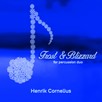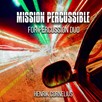
The Quest For The Seagull´s Beak
Composer: Henrik Cornelius
Instrument: Percussion Quartet
Level: Advanced
Published: 2022
Price: €50.00
Item details
-
Description +
-
Duration: 8 min.
Preface
The musical foundation of "The Quest For The Seagull's Beak" is the G double harmonic minor scale (also known as the G Hungarian minor scale), which has D as a beautiful symmetrical center, both visually on the keyboard (illustration below) and musically as the dominant of G. In the beginning of the piece, it appears that this essential, central note has gone missing, and the musicians start their search, creating both anxiety and dissonance. Eventually, when the D is found, peace and harmony can be restored by a natural G minor scale. The many accidentals in the score, are due to the G double harmonic minor scale being a strange mixture of D major and G minor.
Searching for something is also a key idea behind the performance of the work: the search for common, equal sound and musical phrasing. In the introduction, all of the performers gather around the glockenspiel and a small piece of melody is handed down from one player to the next, with each musician building on what they are given. The same mallet is thus passed on like a baton in a relay race. Maybe the musical input will come along?
-
-
Instrumentation +
-
Percussion Quartet
Marimba (5 Octave) - shared by players 1, 3 & 4
Vibraphone
Glockenspiel - shared by all players
Hi-Hat
Susp. Cymbal
Concert Bass Drum
Wood Block (small, high-pitched)
Darbuka (optional pair of Bongo Drums)
Wind Chimes - shared by players 2 & 3
-
-
Watch+
-
Performance by Odense Percussion (Sakari Viitala with Linda Sjökvist, Mathias Haslund Birch and Johan Møllebjerg)
-
-
About the composer +
-
Henrik Cornelius serves as Principal Timpani of the Sønderjyllands Symfoniorkester (South Denmark Philharmonic). He has a passion for playing virtuoso solo works for vibraphone and has co-edited an Edition Svitzer publication of Max Seide Leth's works and events. Henrik is also a dedicated chamber musician, organizer, teacher and lecturer. He received his training in percussion from The Royal Danish Conservatory of Music in Copenhagen.
-
-
Reviews +
-
Review (Percussive Notes, February 2022)
This programmatic “tale” is the newest addition to the percussion quartet repertoire from Danish composer Henrik Cornelius. He uses several different treatments of a simple melody and changes in note densities to tell a story of loss, voyage, discovery, and the joy of a successful quest.
This single-movement piece is split into ten episodes that each have their own character. The opening gradually introduces the main motif on the glockenspiel, with all four players passing the mallet amongst each other. The first episode, “Missing,” features the marimba soloist playing the motif with gradually increased ornamentation through four-mallet permutations. “Fearing” pits melodies against the original theme on a now shared marimba, while the vibraphone contributes the featured line. “Searching” and “Calling” use the non-pitched instruments to create intensity through varying the frequency of their sixteenth-note rhythms, or increasing the intricacy of their playing or optional improvisation. “Spotting” steps back on the tension by using a lot of space, making every note seem deliberate, as if approaching something cautiously. Finally, after a short “Reuniting” chorale, the scalar-based lines of “Easing,” “Recalling,” and “Celebrating” lead us to a calm, satisfying conclusion.
Even though the piece features a marimba soloist, the other players have several opportunities to be featured. Naturally, these other players do not have the same technical difficulties that the soloist has (e.g., four-mallet permutations, four-part-choral playing, and cadenzas), but the vibraphone and glockenspiel do have featured solo lines, plus the accuracy and intensity on the non-pitched instruments creates the nervous yet determined feeling of “Searching” and “Calling.”
This interesting composition has great musical ideas, and also has opportunities for dramatic performance. The moments of passing a mallet around and sharing the marimba give the quartet chances to add physical mannerisms to the presentation, which can enhance the programmatic ideas of search and discovery. In sum, this is a well-crafted work that uses simple devices to tell a story that is easy to follow. This will be a fun piece for any advanced or professional group to perform.
—Kyle Cherwinski
-
-
Credits +
-
With support from Koda’s Cultural Funds
Front Cover graphics and layout: Ronni Kot Wenzell
Sketch: Henrik Cornelius
Translation: Phil Brown
Copyright © Edition SVITZER
www.editionsvitzer.com
-



